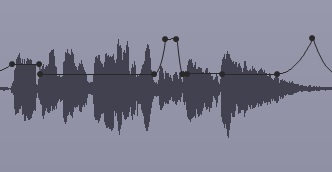Using hand-drawn dynamics for musical emphasis and impact, or to correct minor issues with dynamics
By Rob Stewart - JustMastering.com - Oct 14, 2013
Hand-drawn dynamics are applied in a digital audio workstation (DAW) to either emphasize or de-emphasize certain passages of a song, or even very small portions such as drum transients, or syllables.
The example to the right, is from a recording of a vocal and acoustic guitar, where certain syllables sung by the vocalist were adjusted for musical emphasis. The adjustments (depicted by the line with the dots) have been exaggerated for this view - in the actual piece, they varied only +/- 0.5 to 1.5dB.


Here is another example, this time from a vocal stem, where you can see that two words were adjusted upward, and the fade of the tail of the last word was ramped up just a little to help carry the note a little longer. Because this was a stem, the adjustments were a little more pronounced but not more than 2.5dB.
Drawing in the dynamics by hand is a time consuming process because it takes careful listening, and attention to detail. You can use it to correct for certain words sounding "off mic", or to adjust the perceived rhythm of a passage. The pay-off, in the end, is that you end up with a musical result that supports the original intent or emotional impact of the song.
When dealing with louder, more percussive music, hand drawn dynamics can be used in place of a limiter, where you may only have a handful of peaks throughout the mix that are excessively high. Rather than applying a limiter across the whole mix, you can "draw in" the adjustments only on those few transients you need to. If done correctly it will ultimately sound better in the end because you have effectively removed an extra layer of processing.
Dynamics Adjustments with EQ
Using the same automation features in your DAW, you can also use EQ for dynamics adjustments to adjust only a portion of the spectrum. For example, if there is a strong, deep p-pop (plosive) in the vocal track, you may choose to cut somewhere around 250-500Hz and below with a low-slope high-pass filter just on the "P" part of the word. That effectively reduces the plosive sound while preserving the consonant! The same technique could be used on loud snare hits etc where you want to keep the louder energy of the hit but may not need 100Hz and below for one or two hits. This saves you having to duck the whole snare, allowing you to reduce the peak while maintaining most of the original impact.
Happy mixing!

